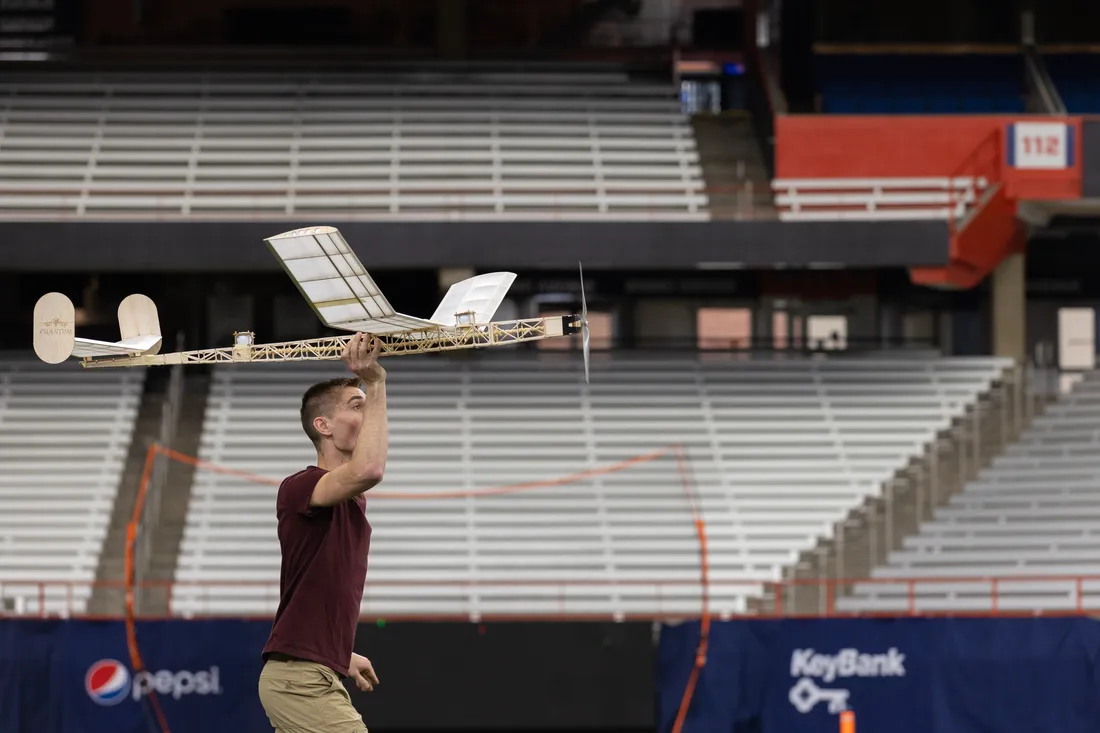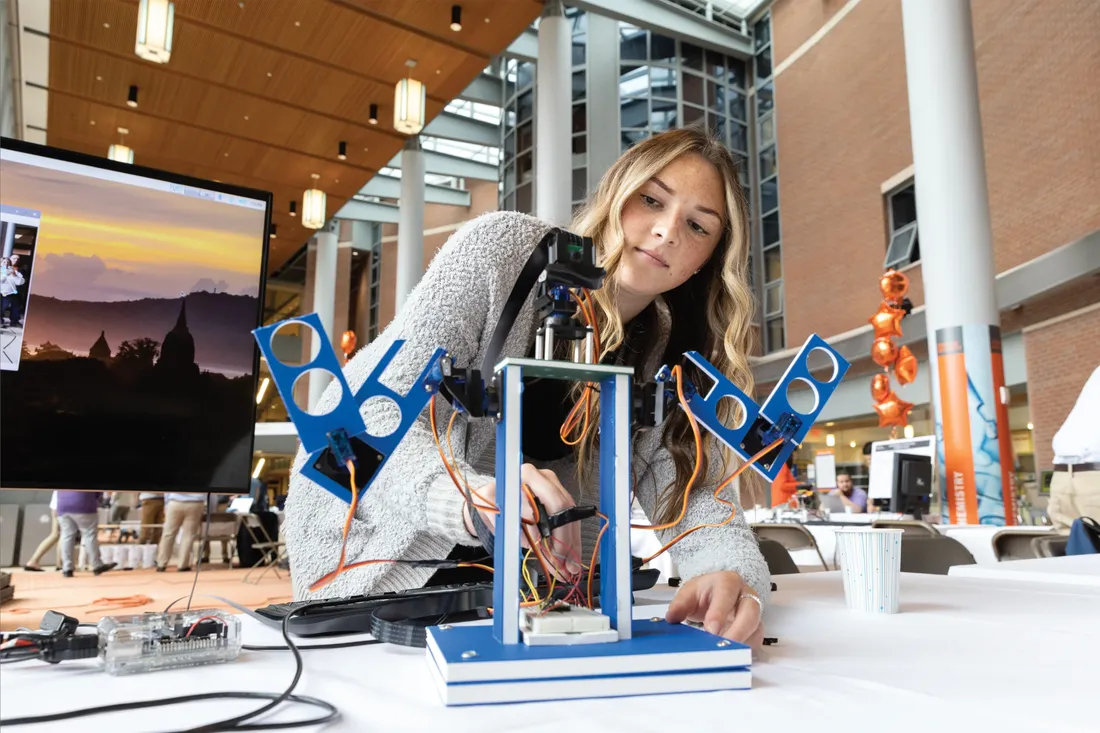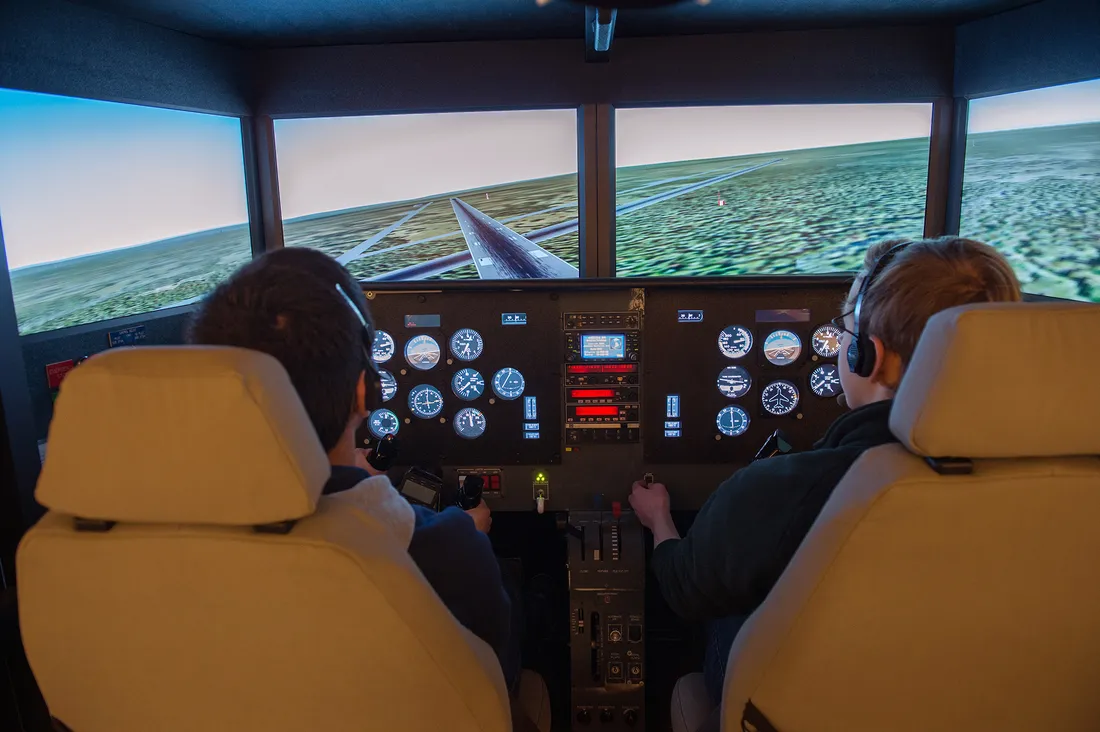
The Fidelity MOTUS 622i, one of the world’s most advanced flight simulators, is based in the College of Engineering and Computer Science.
College is filled with “aha” moments—sudden bursts of insight that usually take place in a lab or classroom. For Sareta Gladson G'22, it occurred at the controls of the Fidelity MOTUS 622i, one of the world’s most advanced flight simulators, housed in Syracuse University’s Link Hall.
Then an aerospace engineering major in the College of Engineering and Computer Science (ECS), she was learning to fly the MOTUS as part of a course in vehicle performance and dynamics.
Everything was going well until the aircraft stalled mid-flight. Gladson seized the control stick to push down the nose, reducing the angle between the wings and the horizon. She then rolled the aircraft level and quickly applied power. The MOTUS slowly climbed, before resuming its original flightpath. Crisis averted.
“What I did was a gut reaction,” recalls Gladson, who graduates in May with a master’s degree in mechanical and aerospace engineering. “I knew conceptually what to do, but until I applied theory to practice, I didn’t fully understand what a stall was. That’s when I began looking at flight simulation training in a new light.”
Experiential Learning at Its Best
Gladson is now one of only three people on campus qualified to operate the MOTUS—controlling all aspects of the simulation, including the destination, lighting and weather conditions, and type of aircraft—as opposed to just flying it. The other two are fellow classmate Paul Mokotoff ’21, G’22 and their professor John Dannenhoffer, a leading authority on computational fluid dynamics.
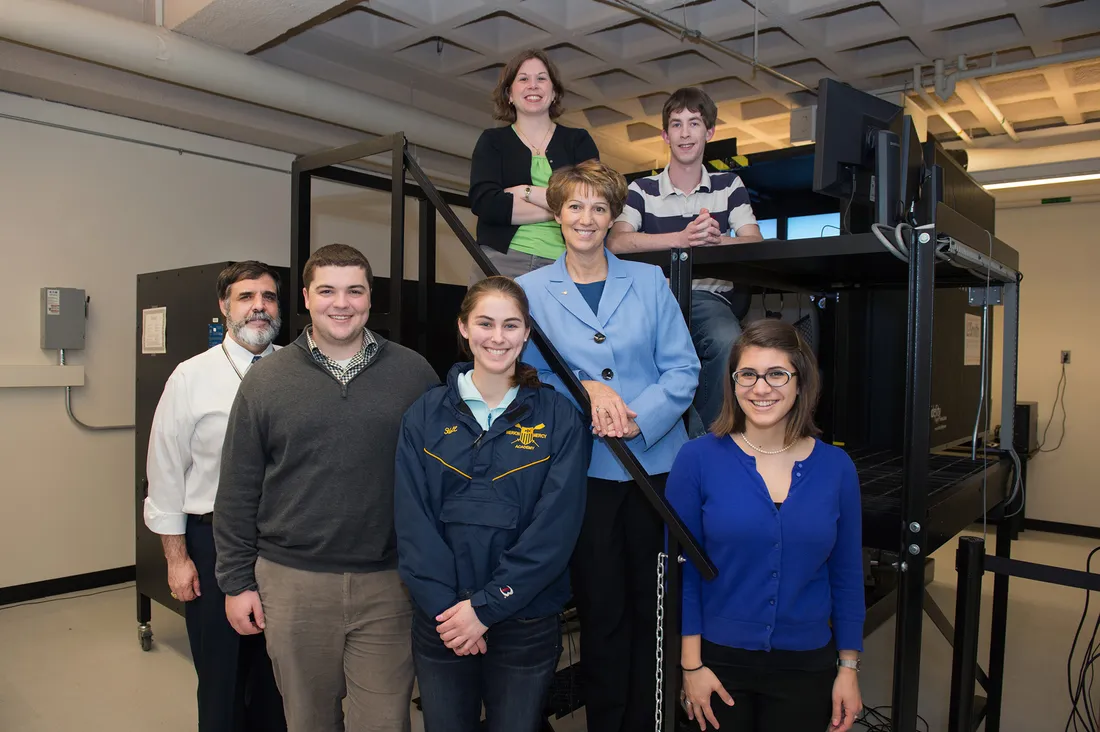
Former astronaut Eileen Collins ’78, H’01 (center) and Professor John Dannenhoffer (far left) with students in Link Hall’s Tango Foxtrot Lab, which houses the MOTUS.
Gladson and Mokotoff were juniors when they half-jokingly suggested that Dannenhoffer hire them as teaching assistants—jobs usually reserved for graduate students—for Introduction to Engineering and Computer Science (ECS 101). “We ended up working as undergraduate graders, but our experience with Professor Dannenhoffer ultimately led to us becoming flight simulator operators,” says Gladson, who has logged about 70 hours in the MOTUS. “Almost anyone can fly a simulator. Operating it is something else altogether.”
Among the operator’s many responsibilities are arranging for virtual landings at and takeoffs from some the world’s busiest (and scariest) airports, like LaGuardia in New York City; the Juancho E. Yrausquin Airport on the Dutch island of Saba; and Gibraltar International, whose runway is bisected by a busy four-lane highway.
There’s even a flight plan to Mars. “It’s not too crowded there,” says Dannenhoffer smiling. “We’re usually No. 1 on the runway.”
It can mean the difference between life and death in a real flight situation. It’s experiential learning at its best.
Paul Mokotoff ’21, G’22
Like Gladson, Mokotoff is enrolled in ECS’s five-year, 4+1 program, where he is concurrently earning a bachelor’s degree in aerospace engineering and a master’s in mechanical and aerospace engineering. Mokotoff considers simulator training an exercise in critical thinking and creative problem-solving. “It can mean the difference between life and death in a real flight situation,” says the aspiring professor. “It’s experiential learning at its best.”
MOTUS Operandi
The MOTUS is a relative newcomer to ECS’ mechanical and aerospace engineering department, where students design and develop high-speed transportation vehicles. The simulator, or “sim” for short, is a major coup for ECS, like what a teaching hospital is to med students. “Many aerospace engineering students never see the inside of a cockpit,” Dannenhoffer says. “The MOTUS has turned our department into a destination.”
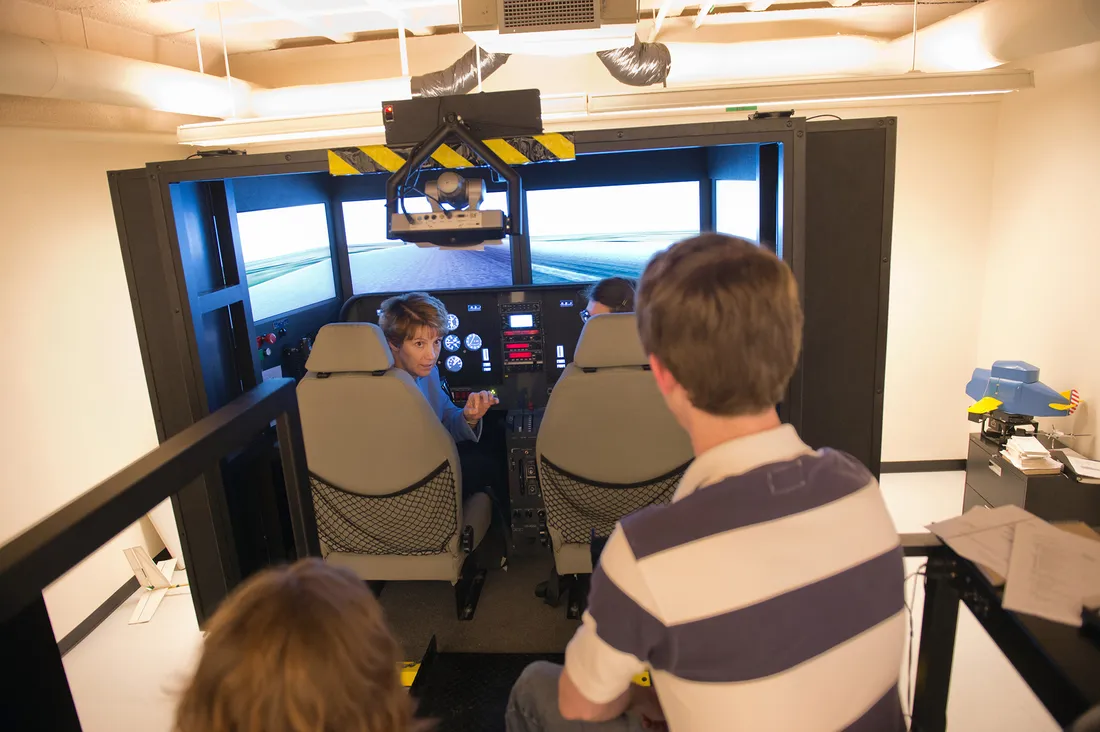
With its six-axis motion base, wrap-around visual system, and lifelike cockpit, the MOTUS blurs the line between fantasy and reality.
With its six-axis motion base, wrap-around visual system and lifelike cockpit, the MOTUS seeks to blur the line between fantasy and reality. Imagine a cool VR game, but better, Dannenhoffer continues. “Two students fly, while two others take notes, and then they swap. Each session is an hour long.”
Open at the rear for crew entry and instructor observation, the MOTUS contains a cockpit configured for a pilot and co-pilot. They face four large LCD monitors, beneath which are a throttle, prop and mixture controls. To the side is a separate monitor for the flight instrument panel, lined with switches for radios, aircraft systems and lights.
The layout is realistic, admits Mokotoff, a longtime member and former president of the campus chapter of the American Institute of Aeronautics and Astronautics (AIAA). He says that whether one is designing or flying an aircraft, the MOTUS enable students to test hypotheses and see their impact in real time.
Then there’s the obvious benefit of fine-tuning skills, techniques, and maneuvers. “It’s great to practice multiple repetitions of events, like instrument approaches and landings, in a safe, carbon-free environment,” Mokotoff adds.
Sim training is so authentic that pilots sometimes lose themselves in it. Dannenhoffer recalls the time he was working in his office when a “bloodcurdling scream” emanated from the MOTUS. “A student thought she was going to die because she was about to crash.”
It’s one of the safest, least expensive ways to experience professional-quality, full-motion flight simulation.
John Dannenhoffer, associate professor of mechanical and aerospace engineering
Which reminds him of the machine’s most compelling benefit—safety. Abnormal flying qualities, like those associated with system failures, foul weather or a rejected takeoff, can’t be practiced in a real airplane. Therefore, the MOTUS offers the next best thing at virtually no cost to students. “Except for an occasional hiccup, the simulator is relatively maintenance free,” says Dannenhoffer. “It’s one of the safest, least expensive ways to experience professional-quality, full-motion flight simulation.”
A Link to the Future
Link Hall’s namesake, Edwin Link H’66, built the world’s first commercial flight simulator in 1929. The son of a Binghamton-based musical instrumental builder, he understood how electronics and pneumatics, like those in keyboards and organs, could be used to mimic flight movement. For much of the 20th century, his Link Trainer was synonymous with best-in-class flight training.
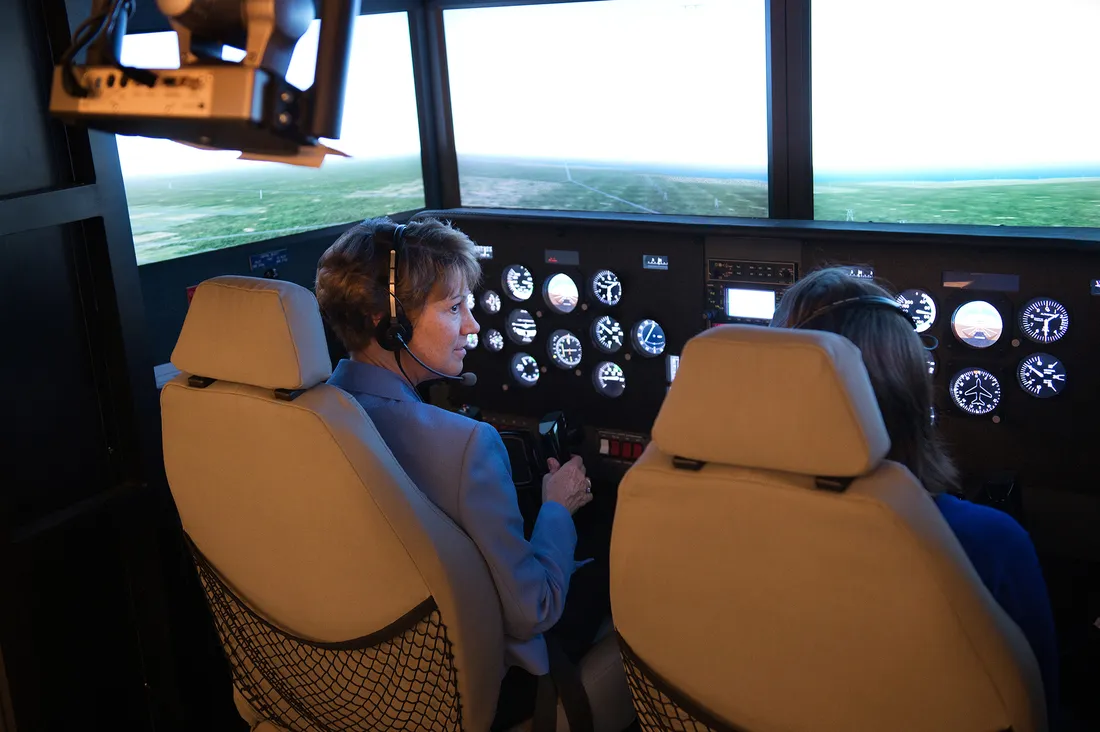
Eileen Collins ’78, H’01 at the controls of the MOTUS, whose cockpit is configured for a pilot and a co-pilot. “It’s great to practice multiple repetitions of events, like instrument approaches and landings, in a safe, carbon-free environment,” says Paul Mokotoff ’21, G’22.
Former ECS Dean Earl Kletsky G’61 obtained and rebuilt a vintage Link Trainer for the University in the late Eighties. Finding the technology wanting, he charged fellow professor Hiroshi Higuchi with procuring a replacement. Higuchi test-drove several sims on both sides of the Atlantic before determining that the MOTUS best met the needs of Syracuse students. He was particularly enamored with the machine’s full-motion capabilities, claiming that they exceeded those of almost any other collegiate flight simulator.
William “Ted” Frantz ’80, a Boeing engineer-turned-investment banker, generously put up the funds in 2007. “It was an easy decision,” he said at the time. “The MOTUS will enable students to experiment with the ‘edge of the envelope’ without endangering any persons or property.” Frantz also covered the cost of installation and established an endowment fund for hardware and software maintenance.
“Ted didn’t want his name on the sim, so we used the NATO phonetic alphabet to symbolize the first letter of his first and last name,” says Dannenhoffer, referring to the glass-plated Tango Foxtrot Lab (“Tango” for “Ted” and “Foxtrot” for “Frantz”), which houses the 225-square-foot MOTUS.
In front of the contraption sits a worn, miniature model of the University’s Link Trainer—a nod to a bygone era and a testament to the possibilities of human ingenuity. The original resides in the Milton J. Rubenstein Museum of Science and Technology near campus. “Even though some aerospace and defense contractors have come and gone, Central New York enjoys a rich aerospace heritage,” says Dannenhoffer, noting that one of Link’s competitors, Glenn Curtiss, hailed from nearby Hammondsport. “I like to think that we have skin in the game.”
High-Flying Opportunity
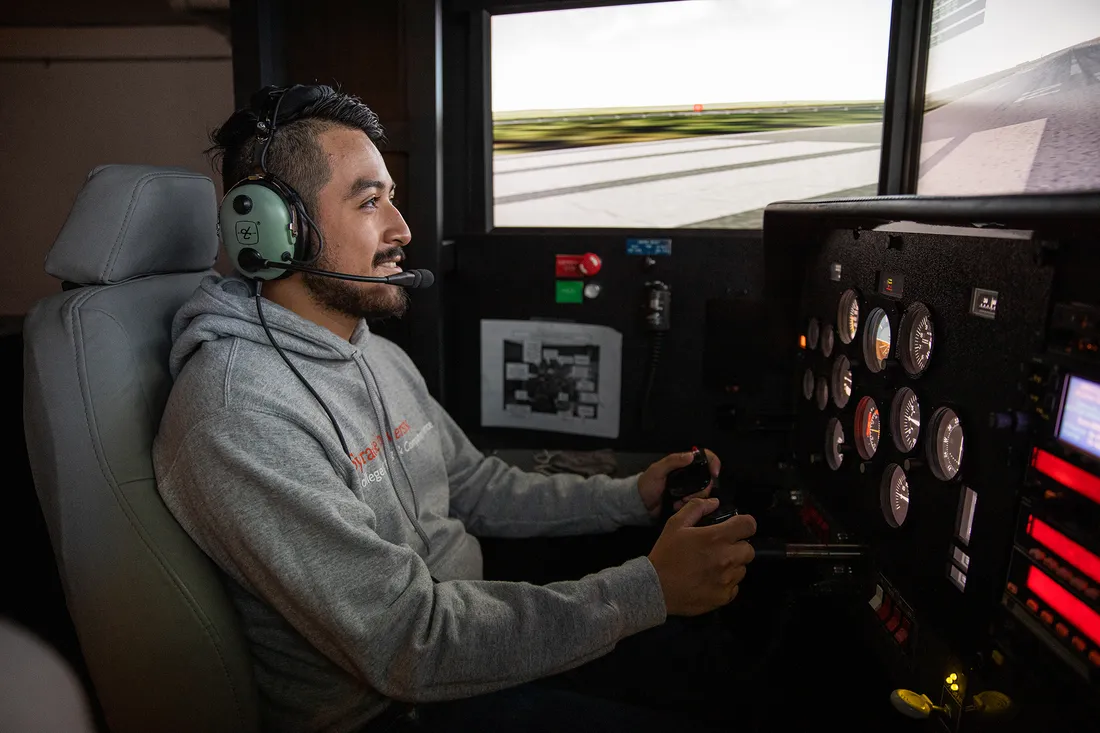
The MOTUS helps students like Elliot Salas ’24, an aspiring spaceship pilot, put theory into practice.
Gladson is parlaying her sim training into a job with the Department of Defense. The 2018 recipient of a Science, Mathematics and Research for Transformation (SMART) Scholarship, she will handle satellite acquisition and tracking for Space Systems Command.
The California native is part of a growing cadre of students and alumni using the MOTUS to prove their mettle. Former astronaut Eileen Collins ’78, H’01 is always good for a session or two during her visits to campus. And Kristin Busa ’09, a vaunted member of the Air Force Research Laboratory, credits the MOTUS for helping her untangle wing aerodynamics and dynamic stability—weighty concepts that even non-ECS students can explore at events like AIAA’s annual Flight Day. “I learned the mathematical basis of aircraft performance and then experienced what these equations meant by flying the MOTUS,” Busa says. “It’s a great way to understand the interface of scientific principles and human control.”
Adds Gladson with a glint in her eye: “It’s easy, once you get the hang of it.”

